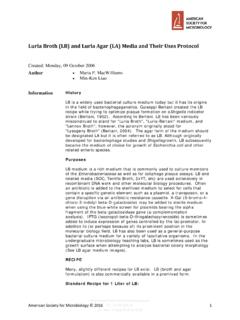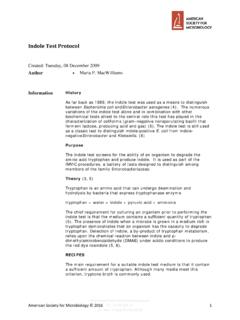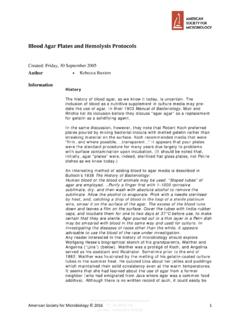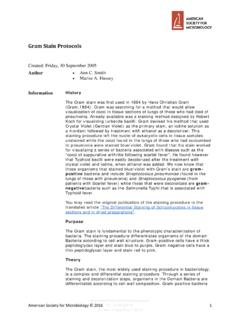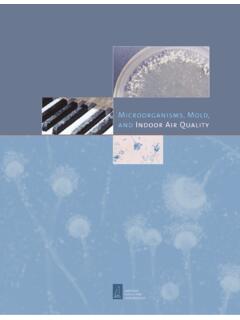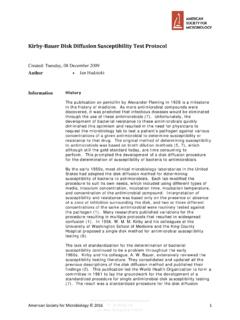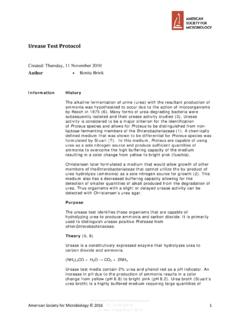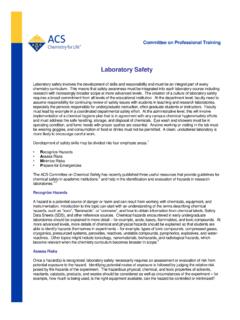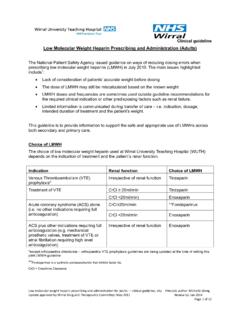Transcription of Oxidase Test Protocol - American Society for Microbiology
1 Downloaded from byIP: : Mon, 12 Aug 2019 20:11:08 American Society for Microbiology 2016 1 Oxidase Test Protocol | | Created: Thursday, 11 November 2010 Author Patricia Shields Laura Cathcart Information History In 1928, Gordon and McLeod (5) introduced the use of a dimethyl-p-phenylenediamine dihydrochloride solution to test for the presence of Oxidase systems. In particular, they used the test to distinguish Neisseria gonorrhoeae( Oxidase positive) from Staphylococcus spp. and Streptococcus spp. ( Oxidase negative). The sensitivity of the Oxidase test was increased when Kov cs found that a tetra-methyl-p-phenylenediamine dihydrochloride solution gave a quicker reaction (8).
2 Gaby and Hadley developed a modified Oxidase test using p-aminodimethylaniline oxalate with -naphthol to detect Oxidase in test tube cultures (3). Purpose The Oxidase test is a biochemical reaction that assays for the presence of cytochrome Oxidase , an enzyme sometimes called indophenol Oxidase (2, 10, 12). In the presence of an organism that contains the cytochrome Oxidase enzyme, the reduced colorless reagent becomes an oxidized colored product (2, 4, 9). Theory The final stage of bacterial respiration involves a series of membrane-embedded components collectively known as the electron transport chain.
3 The final step in the chain may involve the use of the enzyme cytochrome Oxidase , which catalyzes the oxidation of cytochrome c while reducing oxygen to form water (10). The Oxidase test often uses a reagent, tetra-methyl-p-phenylenediamine dihydrochloride, as an artificial electron donor for cytochrome c (1, 2, 15). When the reagent is oxidized by cytochrome c, it changes from colorless to a dark blue or purple compound, indophenol blue (5, 9). Figure 1 contains a diagram of this reaction. Downloaded from byIP: : Mon, 12 Aug 2019 20:11:08 American Society for Microbiology 2016 2 FIG.
4 1. (a) Tetra-methyl-p-phenylenediamine dihydrochloride (TMPD), the Oxidase reagent, is electron rich (reduced) and has no color. (b) In bacteria that contain the enzyme cytochrome Oxidase , one electron from each of four cytochrome c molecules will be temporarily transferred to the enzyme. (c) This creates four electron-poor cytochrome c molecules and an electron-rich cytochrome Oxidase enzyme. (d) As the final step in respiration, the cytochrome Oxidase enzyme transfers four electrons to molecular oxygen and along with four protons, forms two molecules of water, returning the cytochrome Oxidase enzyme to its original state.
5 (e) Instead of acquiring an electron from another component in the electron transport chain, an electron-rich TMPD molecule passes an electron to the electron-poor cytochrome c. Cytochrome c returns to its original state and the resulting electron-poor (oxidized) TMPD radical has a dark blue color. In addition to a positive Oxidase and negative Oxidase reaction, some organisms are classified as variable Oxidase or delayed Oxidase positive. Variability in the Oxidase reaction has been attributed to differences in cytochrome ccomposition, variability in cytochrome oxidases, and overall transport chain composition variability (6, 7, 9, 12).
6 Recipes A. Kov cs Oxidase reagent (8) 1% tetra-methyl-p-phenylenediamine dihydrochloride, in water Store refrigerated in a dark bottle no longer than 1 week. B. Gordon and McLeod reagent (5) Downloaded from byIP: : Mon, 12 Aug 2019 20:11:08 American Society for Microbiology 2016 3 1% dimethyl-p-phenylenediamine dihydrochloride, in water Store refrigerated in a dark bottle no longer than 1 week. C. Gaby and Hadley Oxidase test (3) 1% -naphthol in 95% ethanol 1% p-aminodimethylaniline oxalate Store refrigerated in dark bottles no longer than 1 week.
7 Oxidase reagents are also available commercially in droppers, impregnated disks, and test strips. PROTOCOLS There are many method variations to the Oxidase test. These include, but are not limited to, the filter paper test, filter paper spot test, direct plate method, and test tube method. All times and concentrations are based upon the original authors recommendations . Filter Paper Test Method (8) (Fig. 2) 1. Soak a small piece of filter paper in 1% Kov cs Oxidase reagent and let dry. 2. Use a loop and pick a well-isolated colony from a fresh (18- to 24-hour culture) bacterial plate and rub onto treated filter paper (please see Comments and Tips section for notes on recommended media and loops).
8 3. Observe for color changes. 4. Microorganisms are Oxidase positive when the color changes to dark purple within 5 to 10 seconds. Microorganisms are delayed Oxidase positive when the color changes to purple within 60 to 90 seconds. Microorganisms are Oxidase negative if the color does not change or it takes longer than 2 minutes. FIG. 2. On the left is Oxidase -positive Pseudomonas aeruginosa and on the right is Oxidase -negative Escherichiacoli. Both organisms were Downloaded from byIP: : Mon, 12 Aug 2019 20:11:08 American Society for Microbiology 2016 4 rubbed on a filter that had been dipped in Kov cs Oxidase reagent and allowed to dry.
9 Filter Paper Spot Method (4) (Fig. 3) 1. Use a loop and pick a well-isolated colony from a fresh (18- to 24-hour culture) bacterial plate and rub onto a small piece of filter paper (please see Comments and Tips section for notes on recommended media and loops). 2. Place 1 or 2 drops of 1% Kov cs Oxidase reagent on the organism smear. 3. Observe for color changes. 4. Microorganisms are Oxidase positive when the color changes to dark purple within 5 to 10 seconds. Microorganisms are delayed Oxidase positive when the color changes to purple within 60 to 90 seconds. Microorganisms are Oxidase negative if the color does not change or it takes longer than 2 minutes.
10 FIG. 3. On the left is Oxidase -positive Pseudomonas aeruginosa and on the right is Oxidase -negative Escherichia coli. Both organisms were rubbed on a dry filter that was then treated with one drop of Kov cs Oxidase reagent. Direct Plate Method (7, 10) (Fig. 4) 1. Grow a fresh culture (18 to 24 hours) of bacteria on nutrient agar using the streak plate method so that well-isolated colonies are present (please see Comments and Tips section for notes on recommended media). 2. Place 1 or 2 drops of 1% Kov cs Oxidase reagent or 1% Gordon and McLeod reagent on the organisms.

